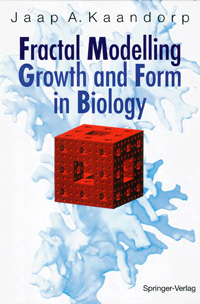Fractal modelling. Growth and form in biology
| Автор(ы): | Kaandorp Jaap A.
06.10.2007
|
| Год изд.: | 1994 |
| Описание: | In this book, Jaap Kaandorp applies mathematical models and computer simulations rooted in fractals to explore the relationship between growth and form in marine sessile organisms: corals and sponges. The sophistication of the models progresses from simple geometric abstractions to comprehensive models of specific organisms found in nature. Commendably, Kaandorp emphasizes the predictive power of the models as the essential criterion of their practical value. One interesting application is biomonitoring, in which a mathematical model is used to establish the relationship between the shape of an organism and its environment. This relationship makes it possible to use the shape of a growing organism as an indicator of environmental conditions. The purpose may range from pollution control to the study of long-term climatic changes. Most of the book is devoted to the description of Kaandorp's original results obtained in the scope of his Ph.D. research at the University of Amsterdam, followed by a fellowship at the University of Calgary. |
| Оглавление: |
 Обложка книги.
Обложка книги.
1.1. Structure of the Book [5] 2. Methods for Modelling Biological Objects [7] 2.1. Reaction Diffusion Mechanisms [7] 2.2. Iteration Processes and Fractals [9] 2.3. Generation of Objects Using Formal Languages [13] 2.4. Diffusion Limited Aggregation Models [18] 2.5. Generation of Fractal Objects Using Iterated Function Systems [23] 2.6. Iterative Geometric Constructions [27] 2.6.1. Geometric Production Rules in 2D Modelling [27] 2.6.2. The Geometric Modelling System for 2D Objects [41] 2.6.3. Modelling a Growth Process in 2D with Iterative Geometric Constructions [44] 2.7. A Review of the Methods [53] 3. 2D Models of Growth Forms [55] 3.1. Modular Growth [55] 3.2. Radiate Accretive Growth [56] 3.3. Growth Forms of Modular Organisms and the Physical Environment [58] 3.4. Description of the Internal Architecture of the Autotrophic Example: Montastrea annularis [64] 3.5. Description of the Internal Architecture of the Heterotrophic Example: Haliclona oculata [66] 3.6. An Iterative Geometric Construction Simulating the Radiate Accretive Growth Process of a Branching Organism [68] 3.6.1. The Basic Construction: the generator [69] 3.6.2. Modelling the Coherence of the Skeleton [74] 3.6.3. Introduction of the Smallest Skeleton Element in the Model [77] 3.6.4. Modelling the "Widening Effect" [78] 3.6.5. Formation of New Growth Axes [79] 3.6.6. Disturbance of the Growth Process, Formation of Plates [82] 3.6.7. Additional Rules for the Formation of Branches and Plates [83] 3.6.8. Formation of Branches [85] 3.6.9. A Combination of the Previous Models [88] 3.7. A Model of the Physical Environment [89] 3.7.1. The Light Model [90] 3.7.2. A Combination of the Geometric Model and the Concentration Gradient Model [92] 3.8. Conclusions and Restrictions of the 2D Model [98] 3.9. List of Symbols Used in this Chapter [100] 4. A Comparison of Forms [103] 4.1. A Comparison of a Range of Forms [103] 4.1.1. A Comparison of a Range of Actual Forms and the Virtual Objects [105] 4.1.2. A Comparison of the Growth Forms of Haliclona oculata Collected in Different Localities [110] 4.1.3. Determination of the Fractal Dimensions in a Range of Forms [110] 4.2. An Experimental Verification of the Model [112] 4.2.1. The Simulation Experiments [113] 4.2.2. The Transplantation Experiments [114] 4.2.3. Comparison of Growth Forms of the Transplants and Simulation Experiments [118] 4.3. Conclusions [126] 5. 3D Models of Growth Forms [129] 5.1. Constructions in Space, a 3D Modelling System for Iterative Constructions [129] 5.2. Description of an Organism with Radiate Accretive Growth and a Triangular Tessellation of the Surface [133] 5.3. Representation of a Triangular Tessellation [134] 5.4. Representation of a Multi-Layer Triangular Tessellation [140] 5.5. The Lattice Representation of a Volume Tessellated with Triangles [142] 5.5.1. The Lattice Model [144] 5.5.2. The Virtual Lattice, a Subdivision of Space [146] 5.6. An Iterative Geometric Construction Simulating the Radiate Accretive Growth Process of a Branching Organism [148] 5.6.1. The Initiator [148] 5.6.2. The Basic Construction: the Generator [149] 5.6.3. Isotropic Growth and the Insertion of New Elements [150] 5.6.4. Anisotropic Growth and the Insertion of New Elements [155] 5.6.5. Formation of Branches [157] 5.6.6. The Coherence Conserving Rules [164] 5.6.7. More Evolved Branching Objects and Collision Detection [165] 5.6.8. A Model of the Influence of Light Intensity on the Growth Process [172] 5.6.9. A Model of the Influence of Nutrient Distribution on the Growth Process [178] 5.7. Conclusions and Restrictions of the Presented 3D Models [182] 5.8. List of Symbols Used in Sects. 5.3 to 5.7 [184] 6. Final Conclusions [189] 6.1. The 2D and 3D Simulation Models [189] 6.2. Application of the Simulation Models in Ecology [191] References [197] Index [205] |
| Формат: | djvu |
| Размер: | 3410993 байт |
| Язык: | ENG |
| Рейтинг: |
107
|
| Открыть: | Ссылка (RU) |